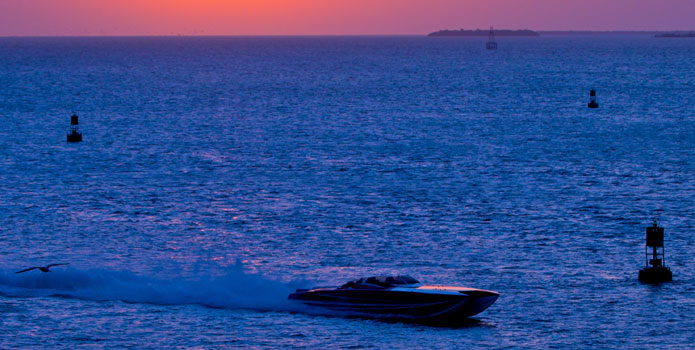Tres Martin’s Safety Corner: Heighten Your Passing Awareness
Chances are good that if you own a high-performance powerboat you’re going to pass other vessels. Even a “slow” performance boat, say one that tops out at 80 mph, is twice as fast as the average wakeboard boat, pontoon boat, runabout and cruiser. As the saying goes, “There are a lot more of them than there are of you”—and they have all the same right to the waterway as you do.
Using heightened awareness in all passing situations can help you get home in one piece at the end of the day. Photo courtesy/copyright Tim Sharkey/Sharkey Images.
You need to be on your game big time—in control and aware of the situation—when you pass another boat. That boat ahead of you? It has the right of way as the “stand-on” vessel. You, as the give-way vessel, are responsible for executing the pass safely.
Judging speed, distance, deciding which side to use for passing, and more—it’s all about heightened awareness that begins before you make the pass.
“Let’s say you’re getting ready to overtake a vessel” says Tres Martin, the founder of the Tres Martin Performance Boat School. “They are the stand-on vessel. They have the right of way. You are the give-way vessel. If the driver of the boat ahead looks back at me once, I am pretty sure he will hold his lane. But if he looks back at me twice, I am pretty sure he won’t because I know he’s nervous. So when I pass him, and I usually like to pass him on my port side so he can see the nose of my boat in his peripheral vision, I want to give him as much room as possible. But in that situation, where I am not sure about the driver ahead of me in the stand-on vessel, if my starboard side has more give-way I’ll pass on that side.
“You also have to pan the area from 11 o’clock to 2 o’clock—let’s say 2 o’clock is land—before you pass,” he continues. “If land is starboard, most drivers who are nervous will tend to takes lines to starboard—they’ll try to drive closer to the shoreline because they thinks it’s safer. It’s just human nature. But knowing that, I’m probably not going to pass him on that side. I am always going to choose the side that has most space. Give yourself as much room to maneuver as you possibly can in case the vessel you’re passing changes lanes. The driver of that boat may suddenly think he needs to go to the marina or restaurant he just passed. I try to put myself in a position where the other driver can see me and know what I’m doing.”
Martin says he sees a lot of go-fast boat drivers speed up to pass vessels ahead of them. Big mistake.
“Exercising the rule of slowing down to pass another vessel at a controllable speed is the best way to go,” he explains. “When I’m passing another boat, I reduce my speed to increase my footprint in the water and handle the wakes and turbulence from the boat I’m passing. When you increase your footprint, when you have more wetted surface, you increase control. You have no control of your vessel when it’s in the air.
“A lot of today’s windshields create distortion,” Martin adds. “They make objects ahead look closer than they are, and they make it look as though you’re going slower than you are. You need to be aware of that, especially when you’re passing stand-on and head-on vessels. And just a quick thing on passing head-on vessels. The standard etiquette for me is to turn my boat slightly to the starboard for a moment to show them my port side so the driver will know I am going to pass him on my port side. A lot of this has to do with courtesy and awareness expressed through non-verbal communication.”
Martin offers one more tip, which while not specific to passing situations can be applied to all boating situations, especially group outings such as poker runs and rendezvous events.
“People often follow way to closely,” he says. “You need to maintain a distance of two to three boat lengths for every 10 mph in that little triangle of boats from 11 o’clock to 1 o’clock ahead of you.”
Editor’s note: Appearing biweekly on speedonthewater.com, “Tres Martin’s Safety Corner” tackles a different aspect of high-performance powerboat safety in each installment
Related stories
Performance Boat School Adding New Instructor In 2014
Tres Martin’s Safety Corner: Inspect Religiously
Tres Martin’s Safety Corner: Refresher Course
Jones Emphasizing Safety Rule Compliance for Upcoming Key West Poker Run
Commentary: We Can Always Slow Down
DCB Includes Driving School with Boat Purchase
Florida Powerboat Club Launches Safety Initiative
Commentary: Play Insurance By the Numbers
Commentary: Building on a Bridge Blunder
Commentary: Ripples from Key West


